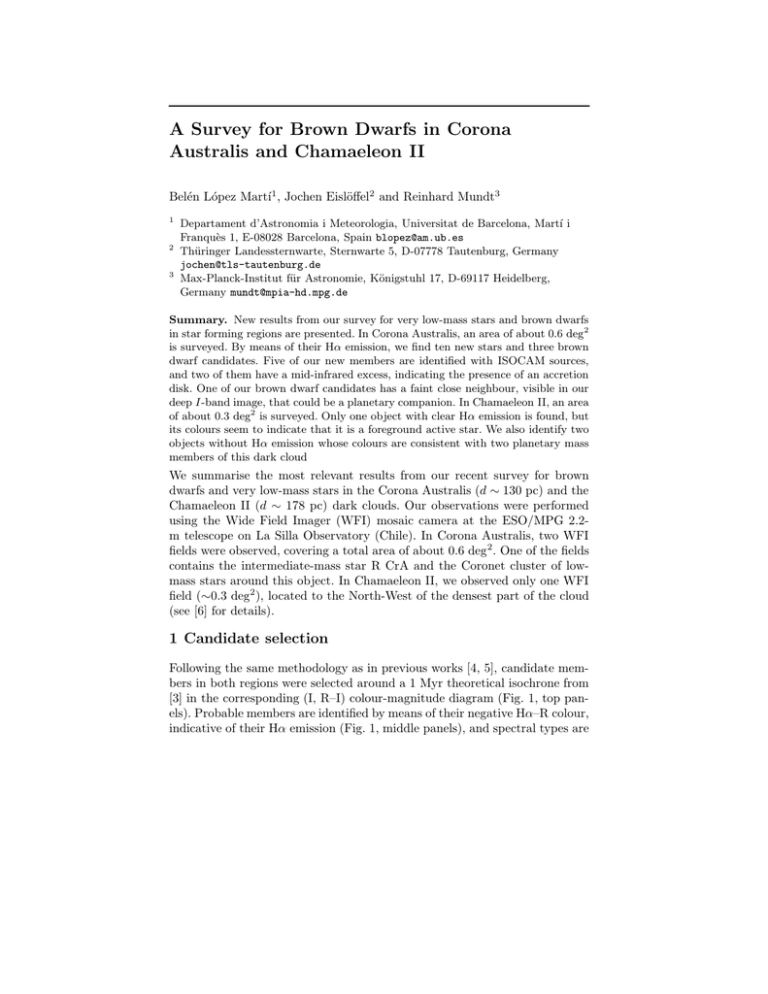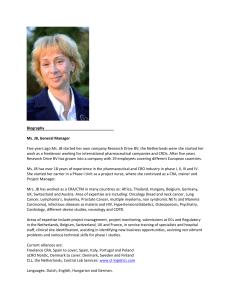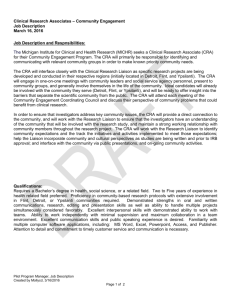A Survey for Brown Dwarfs in Corona Australis and Chamaeleon II
advertisement

A Survey for Brown Dwarfs in Corona Australis and Chamaeleon II Belén López Martı́1 , Jochen Eislöffel2 and Reinhard Mundt3 1 2 3 Departament d’Astronomia i Meteorologia, Universitat de Barcelona, Martı́ i Franquès 1, E-08028 Barcelona, Spain blopez@am.ub.es Thüringer Landessternwarte, Sternwarte 5, D-07778 Tautenburg, Germany jochen@tls-tautenburg.de Max-Planck-Institut für Astronomie, Königstuhl 17, D-69117 Heidelberg, Germany mundt@mpia-hd.mpg.de Summary. New results from our survey for very low-mass stars and brown dwarfs in star forming regions are presented. In Corona Australis, an area of about 0.6 deg2 is surveyed. By means of their Hα emission, we find ten new stars and three brown dwarf candidates. Five of our new members are identified with ISOCAM sources, and two of them have a mid-infrared excess, indicating the presence of an accretion disk. One of our brown dwarf candidates has a faint close neighbour, visible in our deep I-band image, that could be a planetary companion. In Chamaeleon II, an area of about 0.3 deg2 is surveyed. Only one object with clear Hα emission is found, but its colours seem to indicate that it is a foreground active star. We also identify two objects without Hα emission whose colours are consistent with two planetary mass members of this dark cloud We summarise the most relevant results from our recent survey for brown dwarfs and very low-mass stars in the Corona Australis (d ∼ 130 pc) and the Chamaeleon II (d ∼ 178 pc) dark clouds. Our observations were performed using the Wide Field Imager (WFI) mosaic camera at the ESO/MPG 2.2m telescope on La Silla Observatory (Chile). In Corona Australis, two WFI fields were observed, covering a total area of about 0.6 deg2 . One of the fields contains the intermediate-mass star R CrA and the Coronet cluster of lowmass stars around this object. In Chamaeleon II, we observed only one WFI field (∼0.3 deg2 ), located to the North-West of the densest part of the cloud (see [6] for details). 1 Candidate selection Following the same methodology as in previous works [4, 5], candidate members in both regions were selected around a 1 Myr theoretical isochrone from [3] in the corresponding (I, R–I) colour-magnitude diagram (Fig. 1, top panels). Probable members are identified by means of their negative Hα–R colour, indicative of their Hα emission (Fig. 1, middle panels), and spectral types are 2 Belén López Martı́, Jochen Eislöffel and Reinhard Mundt Fig. 1. Colour-magnitude and colour-colour diagrams used to identify new VLM members of Corona Australis (left) and Chamaeleon II (right). In all diagrams, filled red symbols indicate objects with Hα emission, and open blue symbols objects without Hα emission. ’X’ symbols indicate rejected objects. The crosses show the estimated average errors. Upper panels: (I, R–I) diagrams showing the position of the selected objects around a theoretical isochrone from [3] (solid lines). The position and scattering (indicated by the dashed lines) of the isochrones in these diagrams are estimated using distance and reddening measurements towards previously known objects of each cloud [7, 9]. Middle panels: (Hα, Hα–R) diagrams used to identify candidate members; Hα emitting objects have negative Hα–R colours. Lower panels: (M915, M855–M915) diagrams used to assign spectral types. A Survey for Brown Dwarfs in Corona Australis and Chamaeleon II 3 Fig. 2. (J − H, H − K) diagrams of our objects observed by 2MASS in our surveyed areas of Corona Australis (left panel ) and Chamaeleon II (right panel ). The blue lines indicate the loci dwarfs and giants from [2], and the red lines those of young VLM stars at different reddening values according to [1]. Other symbols as in Fig. 1. These diagrams neither confirm nor discard the nature of our candidates, since none of them shows a NIR excess. estimated using the M855–M915 colour indicator (Fig. 1, bottom panels). See [4] for details on this calibration. We made use of published infrared data to look for counterparts of the optically selected objects. A few objects were added to our candidate lists based on their infrared properties (see below). 2 Results 2.1 Results in Corona Australis By means of their optical colours, 12 objects were selected in Corona Australis, of which three (CrA 432, CrA 444, and CrA 465) are brown dwarf candidates, having estimated spectral types later than M6. All our new candidate members have 2MASS NIR colours consistent with membership to CrA, though none of them has a NIR excess. Four of these objects had also been detected by ISOCAM (Olofsson et al. 1999), but only one, CrA 4107 (M4.5, ISO-CrA 177), was observed in both bands. This very-low mass star has a MIR excess indicating the presence of a circumstellar disk. In addition, one object without Hα emission, CrA 466 (ISO-CrA 127), also has a MIR excess according to the ISOCAM data. This is the brightest MIR source in our sample although its position in the NIR colour-colour diagram seems to indicate high extinction (∼8 mag). An independent estimation of extinction towards this object from its R–I colour and estimated spectral type (M4.5) yields a value of only ∼2.5 mag. Hence, it seems that the NIR colours of CrA 466 might be intrinsic to the object, which also hints to the presence of circumstellar material and/or accretion. The non-detection of Hα emission from this very low-mass star might be due to the photometric errors 4 Belén López Martı́, Jochen Eislöffel and Reinhard Mundt Fig. 3. Two possible substellar binaries: In Corona Australis, the brown dwarf candidate CrA 444 could have a planetary-mass companion, CrA 444b, at about 3” (left). In Chamaeleon II, the objects ChaII 304 and ChaII 305 could form a planetary-mass binary with separation of about 2” (right). in the area of the (Hα, Hα–R) colour-magnitude diagram where this object is placed. The brown dwarf candidate CrA 444 (M8.5), could have a very faint companion at about 3” (∼390 AU), seen only in our deepest I image (Fig. 3, left panel). If this object, CrA 444b, indeed belonged to the cloud, it would have a mass below the deuterium burning limit (∼0.013 MSun), hence being a planetary companion to CrA 444. 2.2 Results in Chamaeleon II Only one object with Hα emission is found in Chamaeleon II. However, its position in the (M915, M855–M915) colour-magnitude diagram seems to indicate that it is an early-type foreground or background star. Two similar objects without (measurable) Hα emission, ChaII 304 and ChaII 305 (both M9.5), are separated by 2” (∼360 AU) and have optical colours suggesting two planetary-mass members of Chamaeleon II (Fig. 3, right panel). We only find one 2MASS source at the position of this visual pair, whose NIR colours are consistent with an object below the deuterium burning mass limit. The other member of the pair may have remained undetected by 2MASS. Aknowledgements: This work was supported by the DFG (projects EI 409/7-1 and EI 409/7-2). B. L. M. also aknowledges financial support from the Spanish Ministerio de Educación y Ciencia through a Juan de la Cierva fellowship. References 1. I. Baraffe, G. Chabrier, F. Allard & P. H. Hauschildt: A&A 337, 403 (1998) A Survey for Brown Dwarfs in Corona Australis and Chamaeleon II 2. 3. 4. 5. 6. 7. 8. 9. 10. M. S. Bessell & J. M. Brett: PASP 100, 1134 (1988) G. Chabrier, I. Baraffe, F. Allard & P. H. Hauschildt: ApJ 542, 464 (2000) B. López Martı́, J. Eislöffel, A. Scholz & R. Mundt: A&A 416, 555 (2004) B. López Martı́, J. Eislöffel & R. Mundt: A&A 440, 139 (2005a) B. López Martı́, J. Eislöffel & R. Mundt: A&A 444, 175 (2005b) R. Neuhäuser, F. M. Walter, E. Covino et al.: A&AS 146. 323 (2000) G. Olofsson, M. Huldtgren, A. A. Kaas et al.: A&A 350, 883 (1999) M. H. Vuong, Cambrésy, L. & N. Epchtein: A&A 379, 208 (2001) 2MASS online database at IRSA: http://irsa.ipac.caltech.edu/ 5





